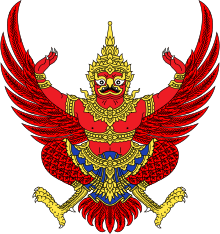Thai literature
 Life in Thailand |
|---|
|
Thai literature is the literature of the Thai people, almost exclusively written in the Thai language.
History
Origins
The earliest literature of the Thai people was written in Chinese until the 13th century, then in Sanskrit and Pali from India.[1][2]
Indian influence
Thai literature was traditionally heavily influenced by Indian culture from the 13th century. Thailand's national epic is a version of the Ramayana called the Ramakien. A number of versions of the epic were lost in the destruction of Ayutthaya in 1767. Three versions currently exist. One of these was prepared under the supervision (and partly written by) King Rama I. His son, Rama II, rewrote some parts for khon drama. The main differences from the original are an extended role for the monkey god Hanuman and the addition of a happy ending.
The most important poet in Thai literature was Sunthorn Phu, who is best known for his romantic adventure story Phra Aphai Mani and for nine travel pieces called Nirats.
Kings Rama V and Rama VI were also writers, mainly of non-fiction works as part of their programme to combine Western knowledge with traditional Thai culture. The story Lilit Phra Lo (ลิลิตพระลอ) was voted the best lilit work by King Rama VI's royal literary club in 1916. Based on the tragic end of King Phra Lo, who died together with the two women he loved, Phra Phuean and Phra Phaeng, the daughters of the ruler of the city of Song, it originated in a tale of Thai folklore and later became part of Thai literature.[3]
20th century
20th century Thai writers tended to produce light fiction rather than literature. But increasingly, individual writers are being recognized for producing more serious works, including writers like Kukrit Pramoj, Kulap Saipradit, (penname Siburapha), and Suweeriya Sirisingh (penname Botan), and Chart Korbjitti. Some of their works have been translated into English. The Isan region of Thailand has produced two notably sociocritical writers in Khamsing Srinawk and Pira Sudham. Notably, Pira Sudham writes in English.
Thailand has had a number of expatriate writers in the 20th century as well. The Bangkok Writers Group is currently publishing fiction by Indian author G.Y. Gopinath, the fabulist A.D. Thompson, as well as non-fiction by Gary Dale Cearley.
See also
- Ka Kee
- Sangsilchai
- Phra Saraprasoet
- Phya Anuman Rajadhon
- Thai folklore
References
- ↑ Haarman, Harald (1986). Language in Ethnicity; A View of Basic Ecological Relations. p. 165.
In Thailand, for instance, where the Chinese influence was strong until the Middle Ages, Chinese characters were abandoned in the writing of the Thai language in the course of the thirteenth century.
- ↑ Leppert, Paul A. (1992). Doing Business With Thailand. p. 13.
At an early time the Thais used Chinese characters. But, under the Indian traders and monks, they soon dropped Chinese characters in favor of Sanskrit and Pali scripts.
- ↑ Thai Literature
